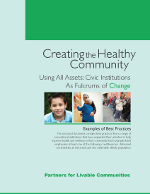
Partners compiled a collection of best practices of traditional community institutions incorporating health and wellness into their agenda and programming to improve community health. The best practices focus on improving the health of at least one of three constituencies: distressed communities, at-risk youth, and the vulnerable elderly.
Examples of institutions include arts and culture organizations, botanical gardens, community development corporations (CDCs), faith-based organizations, libraries, museums, public markets, and zoos.
Click here to download Creating the Healthy Community - Using All Assets: Institutions as Fulcrums of Change
Read more »
Terms:Aging, Community Building, Community Development, Community Engagement, Creating The Healthy Community, Cultural Institutions, Health & Wellness, Healthy Communities, Institutions as Fulcrums of Change , Intergenerational, Libraries, Program Areas, Public Health
On Thursday, the National League of Cities released The 10 Critical Imperatives Facing Cities in 2014, its annual report highlighting ten of the most pressing issues facing cities across the United States. Partners board member and incoming NLC President, Salt Lake City Mayor Ralph Becker explained during the report's unveiling, "This is not a wish list just of cities. This is a wish list of the people who live in America. That’s 80 percent of the population of America that’s being represented through us."
The ten items on the list were:
- Fragile Fiscal Health
- Deteriorating Transportation Infrastructure
- The Shrinking Middle Class
- Inadequate Access to Higher Education
- The Need for Affordable Housing
- A Less-Than-Welcoming Return for Veterans
- Gang Violence
- A Broken Immigration System
- Climate Change and Extreme Weather
- Lack of Public Trust
Click here to read the full report from NLC, which includes an overview of initiatives being taken by cities in their own efforts to tackle these ten challenges and create more livable communities for their residents.
Read more »
Terms:Community Building, Community Development, Downtown Development, Economic Development, Education, Environment, Health & Wellness, Housing, Immigration, Neighborhood Revitalization, Other Reports/Publications, Placemaking, Public-Private Partnerships, Transportation, Urban
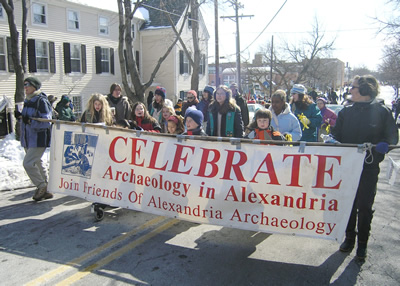
During the 1960s, Washington, DC and its surrounding communities experienced an urban renewal that saw a rebuilding of infrastructure and consequently required the destruction of a number of older buildings in the area. In Alexandria, an independent city a short distance from DC, the destruction of the old buildings uncovered an abundance of historical artifacts that shed light on the history of the area. Realizing that there was a plethora of previously undiscovered, culturally-important artifacts right beneath their feet, the city’s leadership created the Office of Historic Alexandria to try to cultivate and make sense of this new information.
Read more »
Terms:Community Building, Community Engagement, Creative Economy, Cultural Institutions, Heritage, Historic Preservation, IFC Best Practice, Museums, Public-Private Partnerships, Tourism, Washington, DC

New York City is widely considered to be one of the most diverse places on the planet, with residents from hundreds of different countries living within close proximity of each other. Queens in particular has a broad mix of ethnic populations, which have lead some to consider it the most culturally diverse area in the world. Yet, when Susan Lacerte became the Executive Director of the Queens Botanical Garden, she noticed that the diversity of the borough was not reflected in the Botanical Garden’s attendance. To challenge that, Lacerte started The Ambassador Program to reach out to ethnic communities and find out what they wanted in their public garden.
Read more »
Terms:Arts & Culture, Community Building, Community Engagement, Cultural Institutions, Diversity, Healthy Communities, Heritage, IFC Best Practice, Multicultural, New York City, NY, Parks, Playgrounds & Gardens, Urban
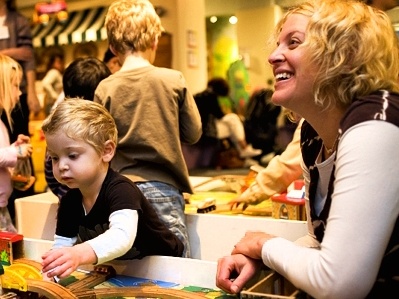
The Habitot Children’s Museum first opened its doors in downtown Berkley in 1998, and the institution has served over 950,000 residents of underserved communities in the Bay Area since. The 7,000 sq. foot facility is home to exhibits that help teach kids about the value of physical activity, water preservation, and art and culture. The hands-on Museum encourages early childhood education and aims to help support a generation of curious and creative kids.
Read more »
Terms:Arts & Culture, Community Building, Creative Economy, Cultural Institutions, Downtown Development, Education, Families, IFC Best Practice, Institutions as Fulcrums of Change , Museums, Youth
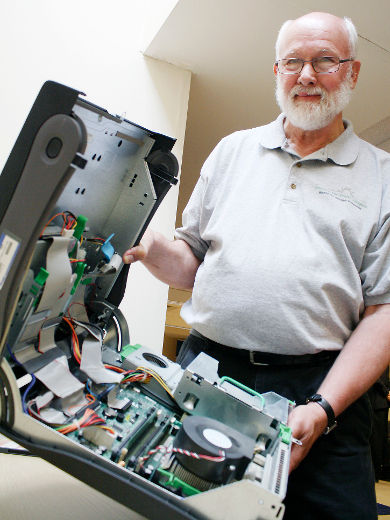
Project Phoenix is an intergenerational program based in Wellend, Ontario, just outside of Niagara, run jointly by the nonprofits Seniors for Youth Niagara and Youth Resources Niagara. The program aims to close the gap between seniors and youth for the purpose of improving the community by giving senior volunteers a chance to interact and share their knowledge and experience with at-risk youth in the area.
Read more »
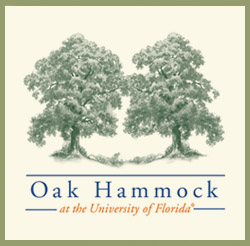
When Dr. Gordon Streib, a sociology professor at the University of Florida, first pitched the idea of sponsoring a retirement community on the UF campus in 1997, it was understandably met with skepticism by the University leadership. It would seem difficult for the late-night lifestyles of college students and the generally more peaceful temperaments of senior citizens to coexist. Nearly 10 years after the retirement community opened its doors in 2004, however, the establishment of the Oak Hammock Retirement Home has proven to be such a resounding success that there is already a waiting list to get in.
Read more »
Cincinnati Magazine published an article on October 30th outlining the recent history of Wilmington, Ohio. Wilmington, like so many small towns across the country, suffered immensely during the recession. In 2008 the town’s largest employer, DHL Shipping, announced that it planned to end its partnership with Airborne Express, who operated the Wilmington Air Park, and find another U.S. partner. The loss of nearly 10,000 jobs meant the city’s unemployment rate skyrocketed from 3 percent in 2007 to 19 percent by 2010. Wilmington quickly became the face of the recession, and large scale impact the economic downturn had received media attention from many major news outlets, including the New York Times and 60 minutes.
Read more »
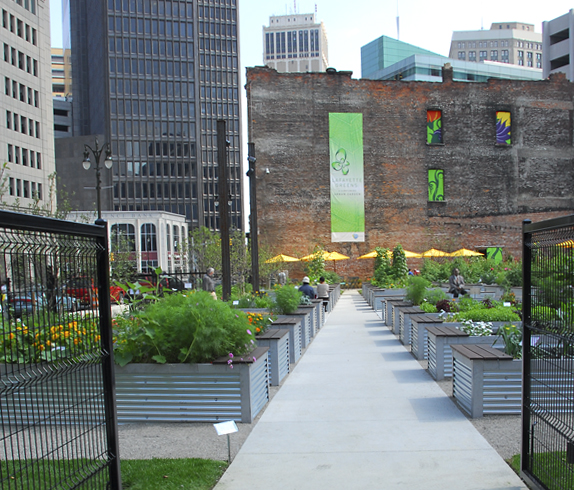
In 1923, when the Lafayette Building was constructed in downtown Detroit, the city was one of the cultural centers of the United States and home to an exploding automotive industry. Famous American architect C. Howard Crane designed the cutting edge, Italian Renaissance-style building in a unique ‘V’ shape to maximize the amount of natural light allowed in. Today, however, Detroit has fallen on harder economic times, and the once striking skyscraper at 144 West Lafayette was torn down in 2010 after being vacant for more than a decade.
Read more »
Terms:Community Building, Cultural Institutions, Downtown Development, Environment, Health & Wellness, Historic Preservation, IFC Best Practice, Neighborhood Revitalization, Parks, Playgrounds & Gardens, Urban

Founded in 2002 in San Francisco, California, 826 is a nonprofit that runs eight writing and tutoring centers for students aged 6-18 nationwide. Each writing and tutoring center provides after-school tutoring at least four days a week, writing workshops to spark students’ interest in the subject, scholarships to helped under-privileged children gain access to a college education, and a variety of other initiatives to help the most at-risk youth further their educational endeavors.
Read more »
“I know that we—the American people—have the ability: to lead the world; to meet today’s energy challenges; to cross the bridge to a cleaner, more secure world; and most importantly, to leave our grandchildren with a place where they can thrive.” – Jim Rogers at the 2012 Democratic National Convention
After welcoming and thanking all those who helped make the 2012 Democratic National Convention possible in Charlotte, North Carolina, Jim Rogers, co-chair of the Charlotte Host Committee at the Convention, began his address by proclaiming that he was not there as a, “Democrat, Republican, policy pundit, or CEO,” but rather, he was there as a concerned grandfather. Rogers continued with his speech by calling for a more broad based long-term effort toward a future of affordable, reliable, and cleaner energy. He went on to state that, “energy is more than a partisan issue. It’s an American issue. And a global issue.”
Jim Rogers’s commitment to identifying and implementing better practices for cleaner and more efficient energy sources has made him a leading figure in not only the energy industry, but the entire environmental movement. As chairman, president, and CEO of Duke Energy, one of the nation’s leading energy providers, Rogers’s prestigious career in the world of energy and politics began after being hired as an Assistant Attorney General for the Commonwealth of Kentucky, where he advocated for the state’s consumers in gas, electric, and telephone rate cases. He was then appointed to Deputy General Counsel for litigation and enforcement for the Federal Energy Regulatory Commission (FERC), and Executive Vice President of interstate pipeline for the Enron Gas Pipeline Group. After joining PSI Energy as the company’s chairman, president, and CEO in 1988, he served as chairman and CEO of Cinergy for more than 11 years before its merger with Duke Energy.
In addition, Rogers has been recognized as one of the most outspoken and respected figures worldwide in the energy industry. In 2011, Rogers was awarded the Asia Society of Washington’s International Business Leadership Award, as well as U.S.-China Policy Foundation’s Global Executive Leadership Award for his work with China to help strengthen the relationship between the two nations, and bring energy to the forefront of global issues. Rogers has testified more than 20 times before U.S. Congressional Committees, has spoken at international forums such as the United Nations General Assembly, the World Economic Forum, the Clinton Global Initiative, and in 2009, Newsweek named him one of “The 50 Most Powerful People in the World.”
Rogers has also done extensive civic work in his current hometown of Charlotte, North Carolina, co-chairing the city’s $82 million campaign to construct a new cultural campus in uptown Charlotte, and by co-chairing Charlotte’s committee to bring the 2012 Democratic National Convention to the city.
Duke Energy has been the largest electric power holding company in the United States for years, supplying energy to approximately 7 million U.S. customers, and was recently named to the Dow Jones Sustainability Index for North America for the seventh consecutive year. With Jim Rogers leading the way, not only does Duke Energy have a bright future ahead of them, but the rest of the world, and especially his grandchildren do as well.
Read more »
Lyz Crane draws on the work of practitioners and researchers to characterize the field of arts-based community development in which arts and culture can help achieve place based change related to the physical, social, and economic dimensions of place. This paper examines the premise that the existence of arts is considered a powerful end in itself, Crane then outlines the variety of ways that the actors and activities involved in arts and community development work can relate to and interact with each other to create sustainable communities. Looking at the cultural ecology of place, creative economy development focuses on fostering local creative businesses and supporting creative workers both in the arts and in supporting industries while cultural development may focus on preserving cultural assets—traditions, language, stories—or on building on them to create stronger, more connected communities. There is also a complex community development ecosystem of organizations, interests, and tools. Stakeholders may involve arts in their agendas, create arts programming, provide or develop arts spaces, employ artists, and/or partner with arts organizations. Indeed, both the arts and community development are part of the same ecosystem and all of these 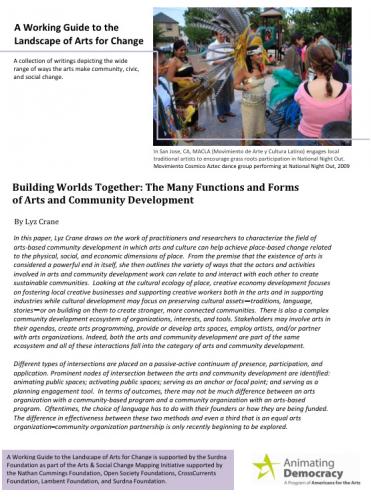 interactions fall into the category of arts and community development. interactions fall into the category of arts and community development.
Crane places different types of intersections on a passive-active continuum of presence, participation, and application. Prominent nodes of intersection between the arts and community development are identified: animating public spaces; activating public spaces; serving as an anchor or focal point; and serving as a planning engagement tool. Crane points out that, in terms of outcomes, there may not be much difference between an arts organization with a community-based program and a community organization with an arts-based program. Oftentimes, the choice of language has to do with their founders or how they are being funded. The difference in effectiveness between these two methods and even a third that is an equal arts organization–community organization partnership is only recently beginning to be explored.
Click here to download the whole document.
Read more »
Terms:2012, Arts & Culture, Business, CBC Report/Publication, Community Building, Community Development, Community Engagement, Creative Economy, Cultural Institutions, Featured, Other Reports/Publications, Placemaking, Public Art, Public-Private Partnerships

By Diana Nash of the Pink Line Project on July 12, 2012
There is a buzzword circulating in the DC arts scene that I had not heard about until I returned to the city two months ago. While the concept of using the arts to spur economic and community development is not new, DC is getting attention for the success of its “Arts and Culture Temporiums” since the first one launched along the H Street NE corridor in 2010. Temporiums fall under the larger category of the Temporary Urbanism Initiative, a project undertaken by the DC Office of Planning. The goal behind the initiative, and more specifically, temporiums, is to activate vacant or underutilized spaces by using them to showcase the talent of local artists and other creative entrepreneurs, along with the retail potential that lies within emerging neighborhoods. Think of them as “Pop Ups” that stay around a little longer and have greater potential benefits for the communities where they take place. Jessica Scheuerman, of Partners for Livable Communities, explains that temporiums allow people to “take risks, explore partnerships, and to commit to something” without the burden of a long-term commitment. Temporiums connect creative people seeking affordable space in their neighborhoods with landlords who have the available space that they haven’t been able to lease. It is a smart and increasingly popular concept that lays the groundwork for longer-term collaboration between property owners and neighborhood entrepreneurs.
Building on the success of earlier temporiums, the Office of Planning is targeting four emerging creative neighborhoods to benefit from a $250,000 grant to the city from ArtPlace, an unprecedented new private-public organization. ArtPlace is part of a national “creative place-making” movement that aims to drive revitalization across the country with arts at the center of economic development. The launch of DeanwoodxDesign marks the next step in the OP/ArtPlace grant initiative.
Read more »
Terms:2012, Announcements, Arts & Culture, CBC Press/Media, Community Building, Creative Economy, Culture Builds Communities, Neighborhood Revitalization, Other Events, Public Art, Washington, DC
 photo credit SCOPE photo credit SCOPE
SCOPE’s (Sarasota County Openly Plans for Excellence) mission is to connect and inspire citizens to create a better community. A private nonprofit, SCOPE is a convener, catalyst and facilitator, partnering with residents to generate collective action around issues affecting quality of life. It is fitting that Sarasota County, as the oldest in the nation and with 30 percent of its residents over 65, focuses considerable attention on aging. Founded in 2001, SCOPE collaborates with Sarasota County residents, elected officials, and community organizations to support broad-based undertakings led by citizens, to solve a variety of community concerns. Initiatives have addressed the environment, transportation, family violence, community change, and the needs of aging residents, to name just a few. All SCOPE activities address issues that strongly influence the quality of life in Sarasota County.
With Sarasota County’s large older adult population, it is not surprising that SCOPE’s perspective on aging is both positive and constructive. It views Sarasota County’s older adults as assets to and active participants in the community. In 2005, to examine the consequences of aging, the opportunities and challenges, SCOPE launched the initiative Aging: The Possibilities. Over 900 residents participated in many discussions, and presentations by experts covered a range of issues relevant to community planning for aging residents—and on their great capacity for enhancing the quality of life in Sarasota County.
Read more »
Terms:2012, Aging, Aging in Place, AIP Best Practice, Chamber of Commerce, City Leaders Institute on Aging in Place, Community Building, Housing, Philanthropy/Community Foundation, Public-Private Partnerships, Transportation
Age Friendly Cities
Rapidly urbanizing world populations are also rapidly aging. The number of people aged over 60 worldwide is expected to double from 11 percent to 22 percent by 2050 [i]. The need to adapt cities to meet the needs of an aging population is more important now than ever, and creating connected cities accessible for all ages is an integral part of responding to these demographic shifts. The World Health Organization (WHO) has been at the forefront of fostering responsible policymaking and networking related to aging in cities, and organized its Age Friendly Cities Project [ii] in 2005.
Read more »
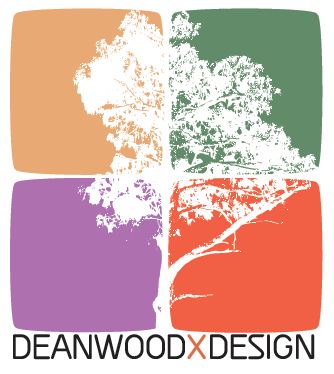 The D.C. Office of Planning (OP) has awarded a $75,000 “ArtPlace Arts and Culture Temporium” grant to Partners for Livable Communities (Partners) to develop and manage temporiums in underutilized spaces in the Deanwood neighborhood, one of the District’s earliest African American communities. The D.C. Office of Planning (OP) has awarded a $75,000 “ArtPlace Arts and Culture Temporium” grant to Partners for Livable Communities (Partners) to develop and manage temporiums in underutilized spaces in the Deanwood neighborhood, one of the District’s earliest African American communities.
Under this grant, Partners will develop and manage DeanwoodxDesign, a project that showcases the rich arts, cultural, historical, and green space assets of Deanwood and Ward 7 through a community-wide, intergenerational, and collaborative effort. This project engages artists and a diverse network of Deanwood institutions and stakeholders to cultivate community pride, showcase and create great art, and invigorate the creative economy.
Read more »
Terms:Announcements, Arts & Culture, CBC Best Practice, CBC Event, Community Building, Community Engagement, Creative Economy, Culture Builds Communities, Design, Multicultural, Neighborhood Revitalization, Placemaking, Public Art, Public-Private Partnerships, Urban, Washington, DC
Rarely does the subject of water inspire poetic phrases or passionate dedications. While we may occasionally recognize its importance, this appreciation is usually offset by the size of the water bill at the end of the month. Regardless, I’m going to ask an odd question: have you ever celebrated water? If I got a single “yes” I would be very surprised, for the simple reason that there are few formalized occasions for the public to appreciate water. This year, a multitude of civic and non-profit organizations have teamed up to give individuals the opportunity to celebrate their “love for water” in the annual Rachel Carson Sense of Wonder Contest.
 2012 marks the 40th Anniversary of the Clean Water Act. Although it was originally enacted in 1948, the Act was significantly reorganized and expanded in 1972 to regulate discharges of water pollutants and monitoring water quality standards in the United States. The Annual Rachel Carson Sense of Wonder Contest is honoring this anniversary and renaming itself the “Sense of Water Contest” for 2012. 2012 marks the 40th Anniversary of the Clean Water Act. Although it was originally enacted in 1948, the Act was significantly reorganized and expanded in 1972 to regulate discharges of water pollutants and monitoring water quality standards in the United States. The Annual Rachel Carson Sense of Wonder Contest is honoring this anniversary and renaming itself the “Sense of Water Contest” for 2012.
Read more »
Terms:Aging, Aging in Place, AIP Best Practice, Arts & Culture, Community Building, Community Engagement, Diversity, Environment, Families, Intergenerational, Youth
Investors in America Award
Janet W. Thompson is honored for her expertise in community development, engagement, and reinvestment in nonprofit and financial management. As Interim President and Chief Executive Officer of the Nonprofit Finance Fund, community consultant to Morgan Stanley, and former Corporate Directorof Community Reinvestment at Citibank, her spirit and leadership has propelled public and private community engagement for more than 35 years.
Read more »
Founders Award for Civic Leadership
James O. Gibson is honored for his leading advocacy in urban revitalization, community development, and race relations. His demonstrated commitment to social equity for more than three decades on issues ranging from civil rights to economic opportunity has provided critical progress for our country’s social fabric.
Read more »
Entrepreneurial American Leadership Award
Robert Pohlman is honored for his foundational advocacy as the Executive Director of the Coalition for Nonprofit Housing and Economic Development. His influential support of the Housing Production Trust Fund and leadership has provided critical construction, rehabilitation, and acquisition of affordable housing units in Washington, D.C. during the past 10 years.
Read more »
|
|